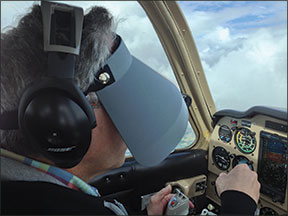BS had been a helicopter pilot in the Army, flying Hueys in Viet Nam. I think he was not quite as comfortable in airplanes as he had been in choppers.
When learning to fly instruments in an airplane, you wear a hood on your head.
No, more like this.
At first you just learn to control the plane's attitude with reference only to the flight instruments. You learn to scan them quickly, but thoroughly. You don't forget to look at any of the instruments, but you don't stay on any one too long. You learn which are the primary references for the different phases of flight. You could easily convince me that following this fundamental process of flying an airplane for 4 decades leads to a low level of anxiety to be constantly shifting your attention through a series of processes. For example, I am watching a Jason Bourne movie as I try to remember my past and type this.
Then you learn to begin navigation in 3 dimensions with instruments and radios. You learn how to read and understand aviation navigation charts for departures, enroute, arrivals and approaches.
So, BS and I are spending time in ground school discussing all this stuff, then going out and putting it all together in the plane. Shortly after takeoff, I put the hood down so that I cannot see outside. We practice non precision approaches to airports, in which we descend to about 500 feet above the ground, following the course depicted on an approach chart. When I would fly correctly to a spot where I could see the airport in the minimum weather conditions for that approach, BS would let me take the hood off. These approaches are frequently not lined up with the runway and require a circling maneuver at low altitude to a point where we are lined up to land.
If I had not flown correctly, the hood stayed on and we would fly a missed approach, which was part of the approach chart. Some times we would do a missed approach even if I had flown it perfectly, because, some times the weather is not good enough to see the airport. Eventually, I am doing all this and talking to Air Traffic Control (ATC) and all BS has to do is sit there and enjoy the ride and the torture he is putting me through, while making sure we don't collide with another aircraft.
Then we started flying precision approaches, Instrument Landing System (ILS) approaches. These are called precision approaches, because they are very precise. Ha. They provide very good course information called the localizer and very good glide slope information via a radio receiver in the plane.
With the training and equipment we had at that time, we flew the ILS to 200 feet above the ground and if BS was going to give me the weather we needed, the hood came off and we landed.
I have to tell you that your mind plays tricks with you doing this stuff, because you kind of don't trust that the radios are taking you to the right place until you have done if many times.
I guess I was pretty good at this, because one day as I was plugging away under the hood, BS asked me, "You like this shit, don't you?"
.jpg/440px-Beyond_the_fog_(Unsplash).jpg)

No comments:
Post a Comment